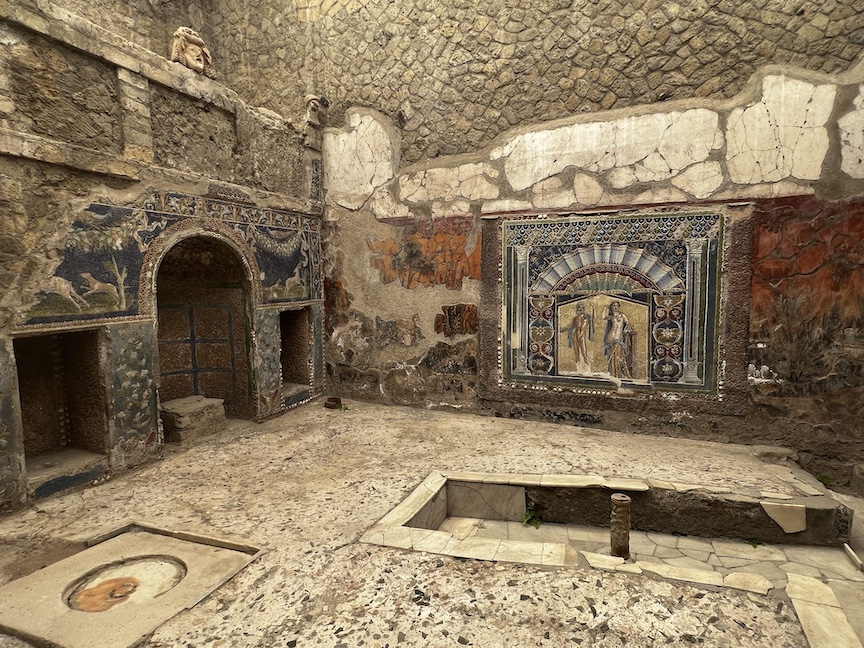
The triclinium (dining room) of Herculaneum’s House of Neptune and Amphitrite gets its name from the outstanding mosaics on its walls. The size of the dining room and its sophisticated construction speak to the wealth of Herculeanum’s residents. Photo by Beth Reiber
By Beth Reiber
The first thing you notice upon entering Herculaneum is how resplendent it is, how unapologetically it asserts itself as Rome’s resort town for the rich and famous. To be sure, you’ve seen plenty of wealthy residents and villas in your hometown of Pompeii, just 5.5 miles away. But whereas Pompeii is a bustling commercial center seething with more than 13,000 people from all walks of life, Herculaneum is a place for pleasure.
To you, this seaside retreat of 4,000 residents seems like heaven on earth, an idyllic setting with cool breezes blowing off the Gulf of Naples to the west and vineyards and olive groves adorning the fertile slopes of Mount Vesuvius, just 2.4 miles to the east. On your hike from Pompeii, you’d felt a few tremors and noticed a plume of ash against a deep blue sky. But you paid them no mind. It’s a glorious late summer’s day.
Herculaneum: a resort for the rich
As you walk Herculaneum’s paved streets, laid out in a geometric grid, you marvel at the sheer concentration of rich citizens you pass, conspicuous due to the fine quality of their colorful togas and the abundance of gold rings, earrings and bangles adorning women. They’re also notably more relaxed, strolling instead of dashing about, smiling as they greet friends, happy to escape Rome’s oppressive summer heat.
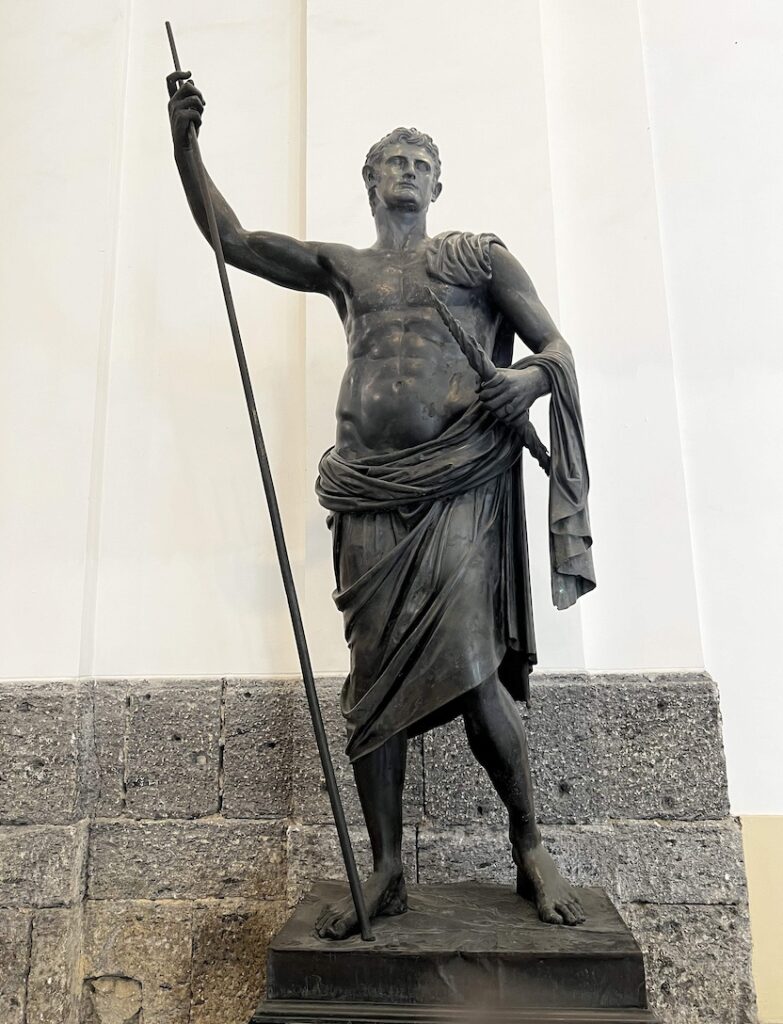
This bronze statue of Augustus deified as Jupiter, dates from the mid-1st century AD and stood in Herculaneum’s Hall of the Augustales when the 79 AD eruption occurred. Like most statuary recovered in Herculaneum, it is now in the Archaeological Museum of Naples. Photo by Beth Reiber
Like most Roman towns, even laid-back Herculaneum is noisy and teeming with life, its streets buzzing with not only the wealthy but also their slaves (dressed, like you, in simple white tunics), townspeople, shopkeepers, freed slaves, wayfarers, carts, horses, and donkeys. You marvel at an infant in the arms of a passing woman, a bulla made of gleaming gold around its neck. Gold! All the bulla amulets you’ve ever seen, worn by babies to ward off evil, have been made of leather or some other inexpensive material. You shake your head in wonderment.
You pass a marble statue honoring the reigning Roman Emperor, Titus [39-81 AD], as well as statues of earlier rulers like Claudius and Augustus and gods like Neptune. But it’s the statue you spot in a mansion’s garden that makes you swoon. No doubt a copy of a Greek deity, the maiden is breathtakingly perfect in every way, her red hair cascading in curls to her shapely shoulders.
You reluctantly move on along Cardo IV Inferiore, noting that not all buildings lining the streets are eye-popping villas. Interspersed among them are modest homes belonging to merchants and tradespeople (freed slaves, perhaps?), their roofs gaily painted in turquoise, red, or green, offset by red and white plaster walls. There are also open-fronted shops selling glassware and other household goods, blacksmiths’ stalls, taverns, and bakeries, sometimes with two or three stories above them that serve as rudimentary quarters for workers or slaves.
Herculaneum also has the usual forum for administrative purposes, a basilica for judicial functions, temples, theaters, fountains, bathhouses, and markets.
You notice that some structures are still undergoing reconstruction, the result of a horrific earthquake about 17 years ago [62 AD) that toppled buildings in Herculaneum, Pompeii, and other settlements like Oplontis, also renowned for its villas. But earthquakes occur so frequently you’re used to them, and the volcano hasn’t erupted for several hundred years. Anyway, aren’t the gods protecting you?
Villas For the Rich and Famous
Your mission for the day is to hand-deliver documents from your owner, one of Pompeii’s most successful merchants, to a handful of Herculaneum’s elite, including senators and politicians. Although your owner’s domicile is impressive, you’ve heard rumors that Herculaneum’s villas are among the finest in the Roman Empire, designed to show off power and status. You’re hoping for a glimpse of their frescoed walls depicting dreamy landscapes with real and imaginary creatures, mosaic floors, ornate furniture, gorgeous marble statues, bronze artwork, fountains, and gardens. If you’re lucky, you might even learn something new about sex, a favorite subject in Roman artwork from frescoes to statuary.
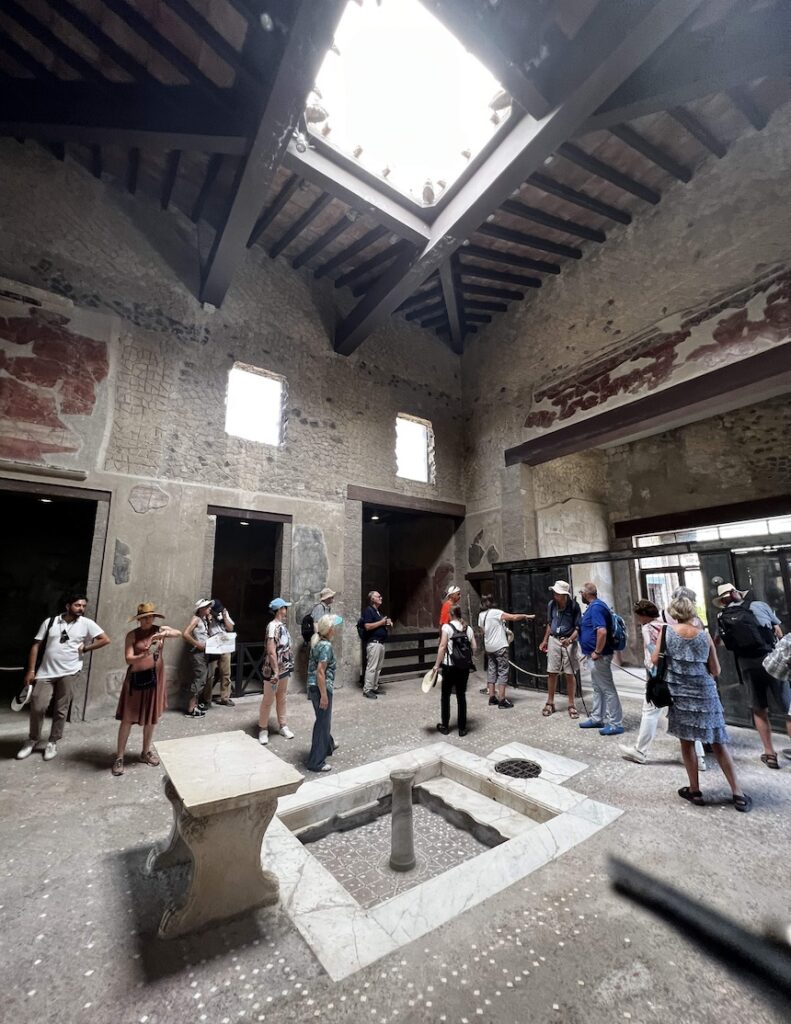
Herculaneum’s House of the Wooden Screen, with its typical roof opening and impluvium for rainwater, is named for its sliding wooden screen. Photo by Beth Reiber
Your first stop is a villa with a large two-story atrium, the home’s public entry room, where the owner conducts business and displays his family’s wealth. Like most atriums, its painted ceiling has an opening for rain, which falls directly into the impluvium (rainwater basin) below it. Colorful frescoes enliven the walls and wooden wardrobes contain family treasures, but you wish you could get a closer look at the miniature temple with its display of ancestral images and idols, which almost certainly includes one of Hercules, the town’s namesake. You can see adjoining bedrooms with their wooden bed frames, but a large wooden screen at the far end has been closed to make the family’s quarters more private.
Next up is the villa once owned by Lucius Calpurnius Piso Caesoninus, senator, philosopher, and father-in-law of Julius Caesar. You’ve heard that it’s one of the most opulent villas ever constructed. It has outstanding frescoes, Greek sculptures, and other artwork. The most valuable treasure, however, are thousands of papyri scrolls, which make this structure one of the most extensive libraries in the Roman Empire. Your reward comes after handing over the document, when you catch a glimpse of the garden and its statue of Pan and his goat, locked in a compromising position and both looking slightly amused. It’s not the romantic scene you were hoping for, but you’re amused, too.
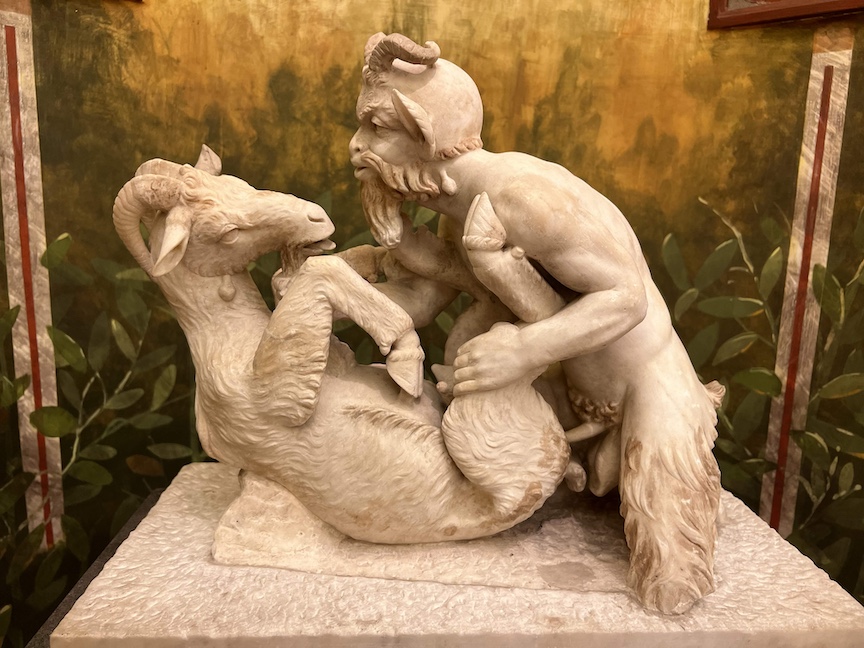
This erotic marble statue of Pan and the goat once stood in the garden of Herculaneum’s Villa of the Papyri. It now resides in the Archaeological Museum of Naples. Photo by Beth Reiber
Daily life in Herculaneum
You’re relieved to come upon one of the city’s many public latrines. You take your spot over one of the holes cut in a row along a long, stone slab. Underneath the holes is a channel of running water, which carries everything away to a cesspit via a sophisticated sewage system.
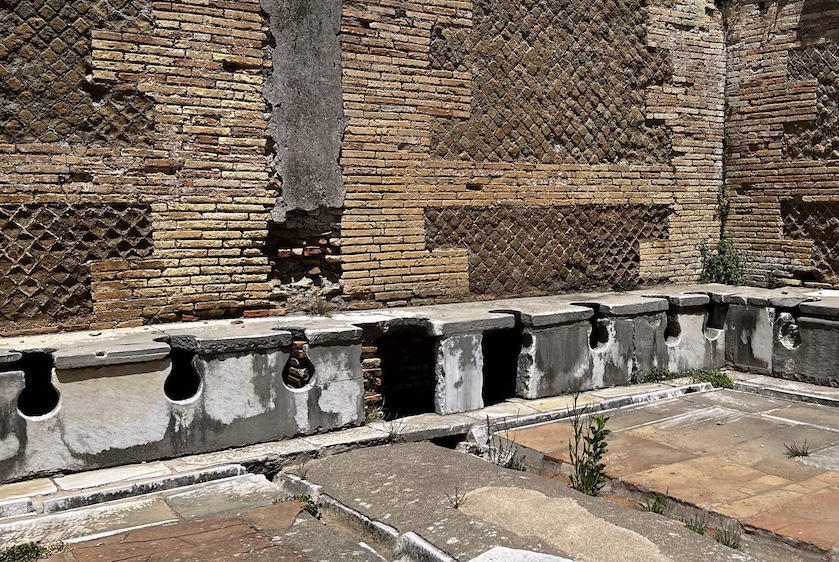
Public latrines in the first century AD were surprisingly commodious, but they weren’t very private. Photo by Beth Reiber
Outside, you quench your thirst at one of Herculaneum’s many public fountains, supplied by a complex system of lead pipes connected to the aqueduct. It’s used mainly by common people, as the wealthy have running water in their homes.
Work Hard and Avoid the Lash
Etched on a nearby wall, along with graffiti (the social media of the time) and public notices, is a warning against the disposal of rubbish. Free men caught littering will be fined, it cautions, while slaves will be flogged. You shudder, but you’re not about to break any laws or bring displeasure from your owner. You know that if you work hard and long enough, you will likely be granted freedom. Maybe you will even move to Herculaneum; you’ve heard that more than half the people living here are former slaves. Some are rich, with villas of their own, citizenship, and an education that includes knowledge of history and the Greek language. If you bear the scars of flogging, however, you will never be granted citizenship.
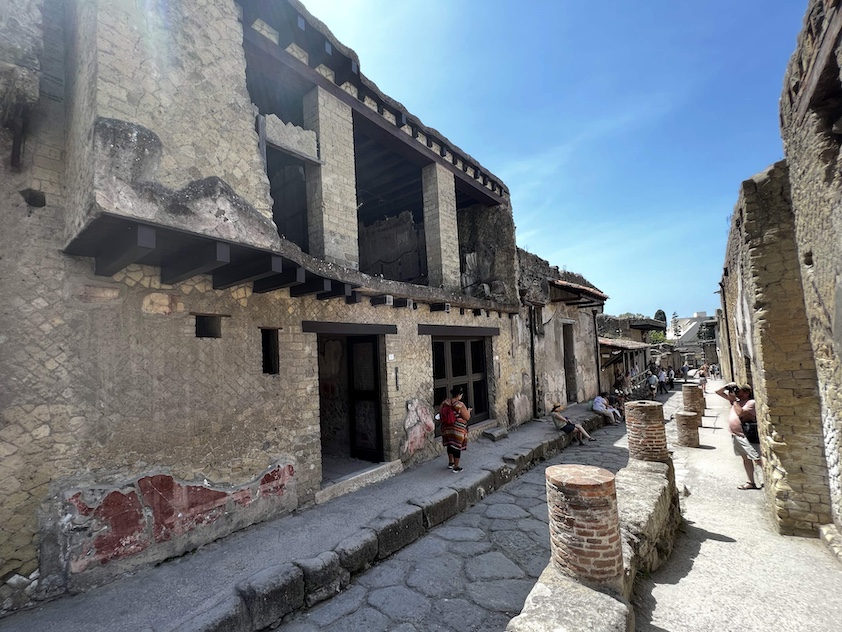
Many of Herculaneum’s structures were two and three stories, with shops and richer families occupying the ground floor and poorer folks relegated to the hot upper floors. Photo by Beth Reiber
You hurry on with your assignment, proud once again that you’ve been entrusted with such an important errand. You race past a raucous crowd gathered around a cockfight and give a wide berth to a funeral procession led by hired musicians making their way to the necropolis on the edge of town. You hear shouts emanating from an open-air gymnasium and visualize young men cheering each other on as they compete in races, boxing, wrestling, the long jump, or throwing the discus and javelin.
You deliver two more documents, but at your last villa you’re informed that the owner has already departed for the public bath, located just across the street. You’re disappointed but not surprised, because daily life revolves around the sun and has already been in full swing since dawn.
For wealthy men, that means conducting business in the morning, eating a light midday meal, and devoting afternoons to the most important order of the day: visiting the thermae, or public bathhouses. Even those who have private baths in their homes frequent a public bath, for leisure, socializing, gossip, and maybe even a business deal. Baths are separated by gender, with the male therma perhaps offering an arena for exercise and the female bath a garden. You can also have your hair cut and styled.
Nothing to be done except to take a break yourself. Although you, too, will reward yourself with a bath before heading back to Pompeii, right now you’ll explore.
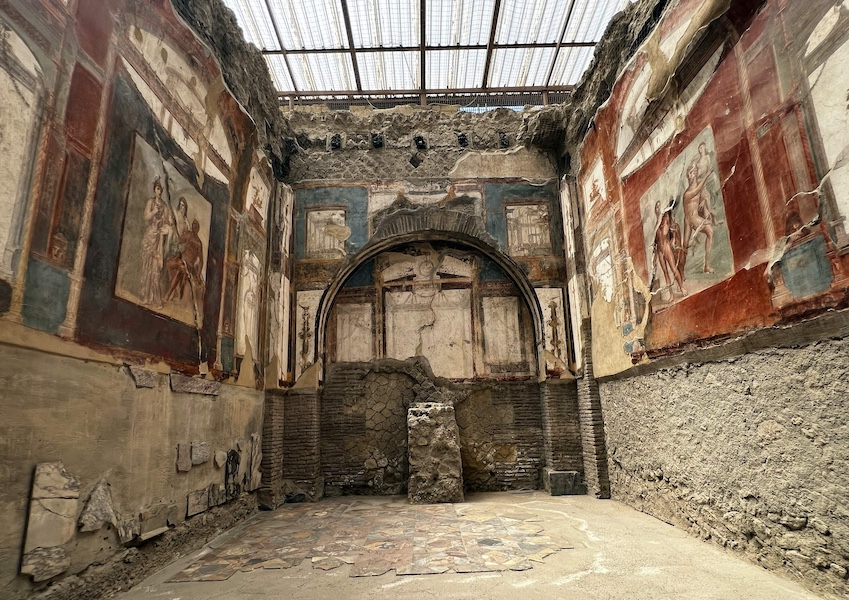
Herculaneum’s Hall of Augustales was constructed while Augustus was still alive. The painting on the left wall depicts Hercules at the entrance to Mount Olympus. Photo by Beth Reiber
You look longingly at the Hall of the Augustales, built while Augustus [62 BC–14 AD] was still alive. Maybe you, too, will one day become a member of the Augustales, an order made up of freedmen dedicated to an imperial cult that worships deified emperors.
Tavernas and markets
Suddenly, you’re ravenous, especially with the smells of freshly baked bread, grilled meats, stews, and other foods wafting from open-fronted bakeries and tavernas. You stop at a taverna to peruse its pictorial menu painted on a wall. Although you don’t earn a wage, your owner feeds and clothes you and provides generally for your wellbeing, and so he’s given you some coins for a meal. You settle on a bit of fish with lentils and a piece of bread, as well as a boiled egg that had been soaked in pine nuts, coated in a mixture of honey and vinegar, and garnished with garum, a fermented fish sauce. Like everyone else, you also order wine and then retire to the open-air back courtyard to scoop up your meal with your fingers.
Your stroll around the city brings you to the market, by far the liveliest spot in the city. It’s a cacophony of vendors shouting their wares, shoppers arguing about prices, goats bleating, chickens squawking, and friends laughing and greeting each other. You walk past displays of fish, meat, chestnuts, grains, grapes, linens, leather sandals, woven baskets, leatherworks, and everything else required for daily living. With the remaining coin left over from your frugal lunch, you splurge on a length of ribbon for your sweetheart.
Feasting and Fornication
You return to your last assigned villa, located behind a wine shop with a wooden balcony and a rack for storing amphorae. You’re informed that the owner is already entertaining guests for cena, the largest meal of the day. Seeing your crestfallen face, the servant takes pity and leads you to the triclinium (dining room), where you see the host and his visitors lounging on couches, laughing, drinking, and using their fingers and bronze spoons to dine on the feast before them. No one pays you any mind, nor do they give more than cursory glances at the musicians and dancers before them. You focus on the room’s frescoes and an outstanding wall mosaic of Neptune and Amphitrite, trying to tame your rumbling stomach.
The couches are grouped around low tables, which are laden with the remnants of half-eaten white bread, salted fish, eel, hare, eggs, olives, Lucanian sausage, goat cheese, and sea urchin, a delicacy boiled in broth and sweet wine and garnished with pepper, mint and bay leaves. You also see roasted dormice, small rodents that are seasoned with herbs, coated in poppy seeds, and dipped in honey. You’ve never eaten one, but your owner, too, breeds dormice, housing them in dark ventilated terracotta pots for hibernation and fattening them up with nuts and honey.
You wait patiently as servants scurry back and forth, gathering up the half-eaten trays of food and returning with platters of dates, peaches, cherries, apples, and the region’s signature figs. But it’s the pear patina that wins loud approval, made by boiling pears, grinding them into a paste mixed with pepper, cumin, honey, passum (a sweet raisin wine), garum, and olive oil, and combining them with eggs before shaping them into pancakes for frying.
Finally, the host waves you over, but he barely looks at the delivered scroll before passing it on to a slave as you’re escorted out to the street. You wonder what the next few hours hold for the revelers, as you know from hearsay that festive banquets, fueled by wine, sometimes progress to sexual pleasure.
Ending the day with a bath
Free! You need to be home before nightfall, but there’s still enough time for a well-deserved bath. On the recommendation of a villa’s slave, you enter a simple therma, which like all the others has a frigidarium with a cold-water plunge, a hot, dry tepidarium with a heated mosaic floor, and a caldarium with a pool of hot water. You linger in the caldarium, congratulating yourself for a job well done and feeling superior to the slaves hidden from view, toiling at the bronze boiler that heats the water soaking away your cares. It’s been, you think, a perfect day.
The Day Herculaneum Died
In 79 AD, life in Herculaneum tragically came to a roaring halt when Mount Vesuvius erupted (although August was thought to be the month, recent discoveries suggest it was October).
The eruption was slow at first, giving many people time to escape. Others made their way to the beach, lighting the dark pathways with lanterns and bringing with them keys to their homes, jewelry, work tools, money, and other valuables. Women and children took refuge in arched storage vaults, while men gathered along the beach. Perhaps they were waiting for rescue boats, which, buffeted by winds and waves, never arrived.
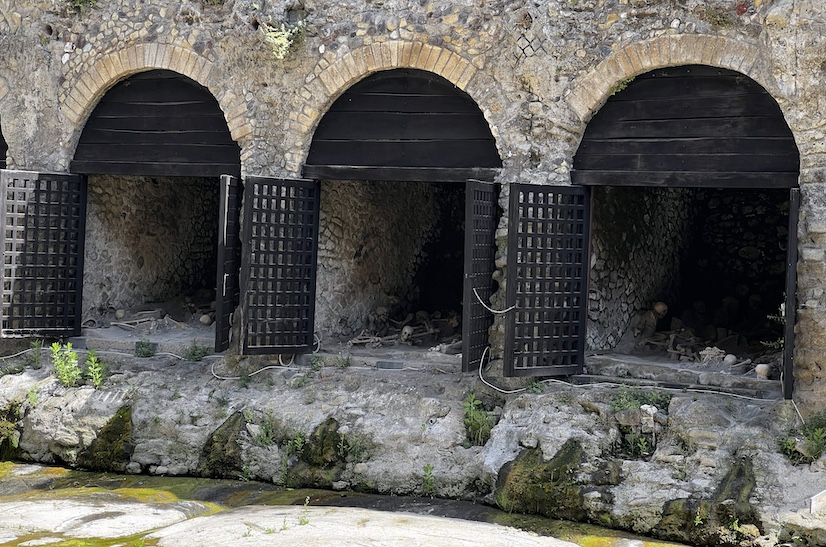
Skeletons discovered on what was once Herculaneum’s shoreline yield information on inhabitants’ health and lifestyle. Photo by Beth Reiber
And then came the first of several pyroclastic surges of volcanic gases and rock, rushing down the volcano at 50 miles an hour at a temperature of more than 750 degrees F. People died instantly, including a mother embracing her baby, a child with his dog, and a pregnant woman with her 8-month unborn child.
By morning all traces of the town had vanished, sealed under 80 feet of solid volcanic rock. The coast was now more than 1,300 feet farther out into the sea.
How Herculaneum differs from Pompeii
Herculaneum’s tragic demise froze it in time for more than 16 centuries, until a farmer digging a well in the early 18th century unearthed evidence of the ancient town. What makes Herculaneum’s discovery unique is that the heat of the pyroclastic surge was so intense, it instantly carbonized and preserved all organic material, including wood, food, plants, and victims.
As a result, Herculaneum provides a breadth of preservation you can’t see anywhere else, making it a window into the daily lives of Romans during the first century AD (by contrast, Pompeii was covered in hot volcanic ash, leaving it more susceptible to the elements). It’s a scholar’s dream.
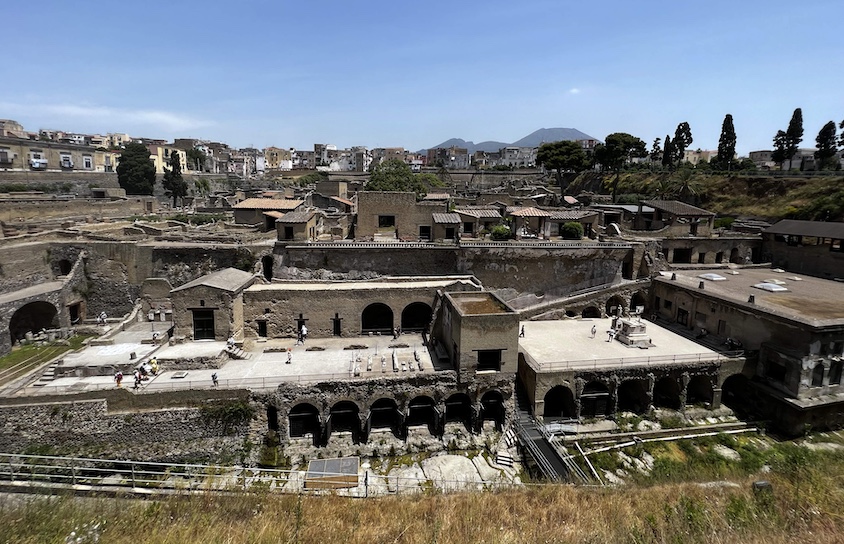
Only a fourth of Herculaneum, shown here with Mount Vesuvius in the background, has been excavated due to the modern town of Ercolano built on top of it. Photo by Beth Reiber
Not only were more durable structures like homes, sewers, baths, statues, and shops preserved, but also wooden furniture like beds and chests, textiles, legal documents inscribed on wax tablets, food, wine racks, and the hull of a 29-foot boat. Latrines and sewers have turned up 110 types of foods, including shellfish, fruits, and vegetables.
The 1,800 scrolls from what is now called the Villa of Papyri, perhaps the largest surviving library from the Greco-Roman world, are being studied and deciphered using modern imaging techniques. The 300 skeletons found on Herculaneum’s shore tell us stories about the victims’ diet and lifestyle.
Yet Herculaneum lives in the shadow of Pompeii, both registered together as a UNESCO World Heritage Site. Herculaneum is smaller, to be sure, with only a fourth of its original 50 acres excavated, compared to Pompeii’s 110 excavated acres. But Herculaneum also receives far fewer visitors, about 400,000 annually compared to Pompeii’s 3.5 million visitors a year.
Where to see treasures from Herculaneum and Pompeii
But regardless of which ancient town you visit, be sure to also see the National Archaeological Museum of Naples, filled with mosaics, statues, frescoes, and other treasures gleaned from the excavated cities. Strolling the ruins of Pompeii or Herculaneum presents the larger picture of the Roman way of life, but the museum brings home how artfully and robustly those ancient lives were lived.![]()
From her base in Lawrence, Kansas, Beth Reiber roams the world writing travel articles and guidebooks. This is her first story for the East-West News Service.

